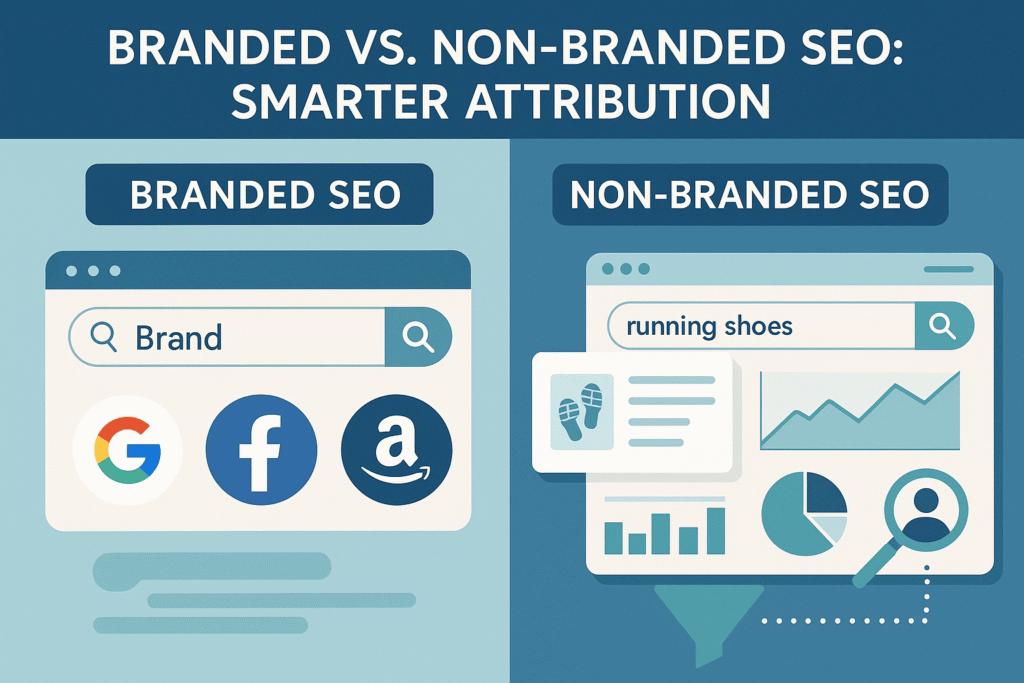When you’re trying to measure the real impact of your SEO efforts, there’s one mistake that can silently skew your entire strategy—confusing branded traffic with actual SEO success.
Sure, seeing an uptick in clicks feels great. But if that spike is coming from people already searching for your brand, you’re not capturing new market share—you’re just catching people who already know you exist.
To really grow through SEO, you’ve got to understand the difference between branded and non-branded SEO. That’s where smarter attribution comes into play.
Let’s unpack it.
What’s the Difference Between Branded and Non-Branded SEO?
At its core, it comes down to who already knows you vs. who’s just discovering you.
- Branded SEO: When someone searches using your brand name or a variation of it. For example, “Trello app,” “Slack pricing,” or “HubSpot CRM.”
- Non-Branded SEO: When someone searches for a topic, solution, or product without using any brand names. Like “best project management tool” or “free CRM for startups.”
Why It Matters
Here’s the problem: if you lump both types of traffic together in your analytics, you’re not getting an honest picture of how well your SEO strategy is actually performing.
Branded traffic often comes from existing awareness—through ads, word-of-mouth, social media, or even old-fashioned PR. Non-branded traffic is what SEO really earns.
If you want to grow, scale, and attract new customers, non-branded SEO is where your focus should be.
Why Branded Traffic Isn’t Enough to Measure Success
Branded searches are important—they show that your brand is gaining recognition. But they shouldn’t be the main indicator of SEO success. Here’s why:
- It’s not discoverability: Branded traffic tells you someone already knows you. Your content didn’t necessarily help them find you—it just helped them get to your site.
- It can create false positives: You might think your new blog post is crushing it, but the traffic spike could be from a recent brand campaign instead of organic discovery.
- It skews conversion data: Branded traffic tends to convert better, making your overall SEO metrics look stronger than they really are.
To measure the actual lift from SEO, you need to isolate the non-branded traffic that shows your content is reaching people who’ve never heard of you before.
How to Track Branded vs. Non-Branded SEO Performance
So how do you untangle the data and see what’s what? Let’s walk through it.
1. Use Google Search Console Filters
This is one of the simplest ways to separate branded from non-branded queries.
- Go to Performance > Search Results
- Click on “+ New” > Query
- Use regex filters like: markdownCopyEdit
^(?!.*(yourbrand|yourproduct)).*$
This tells GSC to show only queries that don’t include your brand name.
Want branded ones? Just use:
CopyEdityourbrand|yourproduct
2. Segment Keywords in Your SEO Tools
Tools like Semrush, Ahrefs, or Ubersuggest allow you to export your keyword list. From there, you can manually tag them:
- Branded = any keyword with your company, product, or team member’s name
- Non-Branded = everything else
This gives you two clear performance buckets. You’ll likely see that branded keywords have higher CTRs—but non-branded ones show you where you’re attracting fresh eyes.
3. Review Assisted Conversions in GA4
This one’s gold.
In GA4, you can explore assisted conversions by looking at the journey a user took before converting. Many will start from non-branded searches like blog posts or guides and end on a branded query when they’re finally ready to buy.
It’s a powerful reminder that just because a conversion is credited to a branded keyword doesn’t mean that’s where the journey began.
How Smarter Attribution Leads to Better SEO Strategy
When you know what kind of traffic your content is attracting, you can make smarter decisions.
Focus on What’s Really Driving Growth
Branded SEO is about capturing interest you’ve already created elsewhere. Non-branded SEO, on the other hand, is about creating new interest.
By tracking both separately, you’ll:
- Understand which content actually drives awareness
- See how your SEO brings in new leads
- Stop over-crediting brand equity to your blog
Improve Budget Allocation
Maybe you’re investing heavily in blog content, but it turns out all your traffic is branded. That might mean people are just using your blog as a branded search shortcut—not discovering you organically.
On the flip side, if your non-branded content is ranking and pulling in traffic, that’s proof your SEO strategy is working. Now you know where to double down.
A Real-World Example: SaaS Attribution Gone Wrong
We worked with a growing SaaS brand that thought their SEO efforts were generating massive traffic. And they were—until we broke things down.
The Problem
80% of their organic traffic was from branded queries. “AppName login,” “AppName integrations,” and “AppName reviews” made up the bulk.
Sure, the numbers looked good. But that wasn’t SEO doing the heavy lifting—it was brand recognition built through paid and social.
The Fix
Once we filtered out branded keywords, we discovered their how-to guides and comparison posts were actually bringing in qualified traffic from people who’d never heard of them.
That’s the kind of insight attribution gives you. And it’s the only way to scale smart.
Tips to Strengthen Non-Branded SEO Without Losing Branded Value
Want to grow your reach without ignoring the value of your brand? Try these:
- Create topic clusters around non-branded keywords: Think “how to fix X,” “alternatives to Y,” or “best tools for Z.”
- Build links to your evergreen, informative content (not just your homepage).
- Use branded assets (like infographics or tools) to get attention—but host them on non-branded content pages.
- Always map your content to searcher intent, especially in the awareness and consideration stages.
The more you help people solve problems before they know you exist, the more you become the brand they remember later.
Final Thoughts: Clarity is Power
If you’re not separating branded from non-branded SEO, you’re operating with blurred vision.
True SEO success comes from earning attention, not just catching it when someone already knows your name. Attribution gives you clarity. And clarity helps you scale smarter, spend wiser, and create content that truly converts.
Need help tracking and optimizing the right SEO metrics? Try the smart SEO reporting features over at SEOsets—they’re built to help marketers like you cut through the noise and focus on what actually works.
FAQs
1. Why is non-branded SEO harder to rank for?
Because you’re competing with everyone—not just your own branded space. But the payoff is bigger since it captures new audiences.
2. Should I completely ignore branded traffic in my reports?
Not at all. Just don’t let it cloud your judgment. Track it separately to see how brand awareness is growing.
3. Can branded and non-branded keywords work together?
Yes! Non-branded keywords build awareness, which often leads to branded searches later in the customer journey.
4. How often should I audit my branded vs. non-branded performance?
Quarterly is a good rhythm. Monthly if you’re actively scaling content.
5. What’s a good branded-to-non-branded traffic ratio?
There’s no one-size-fits-all, but for growing brands, a healthy sign is seeing 40–60% of traffic coming from non-branded terms.


